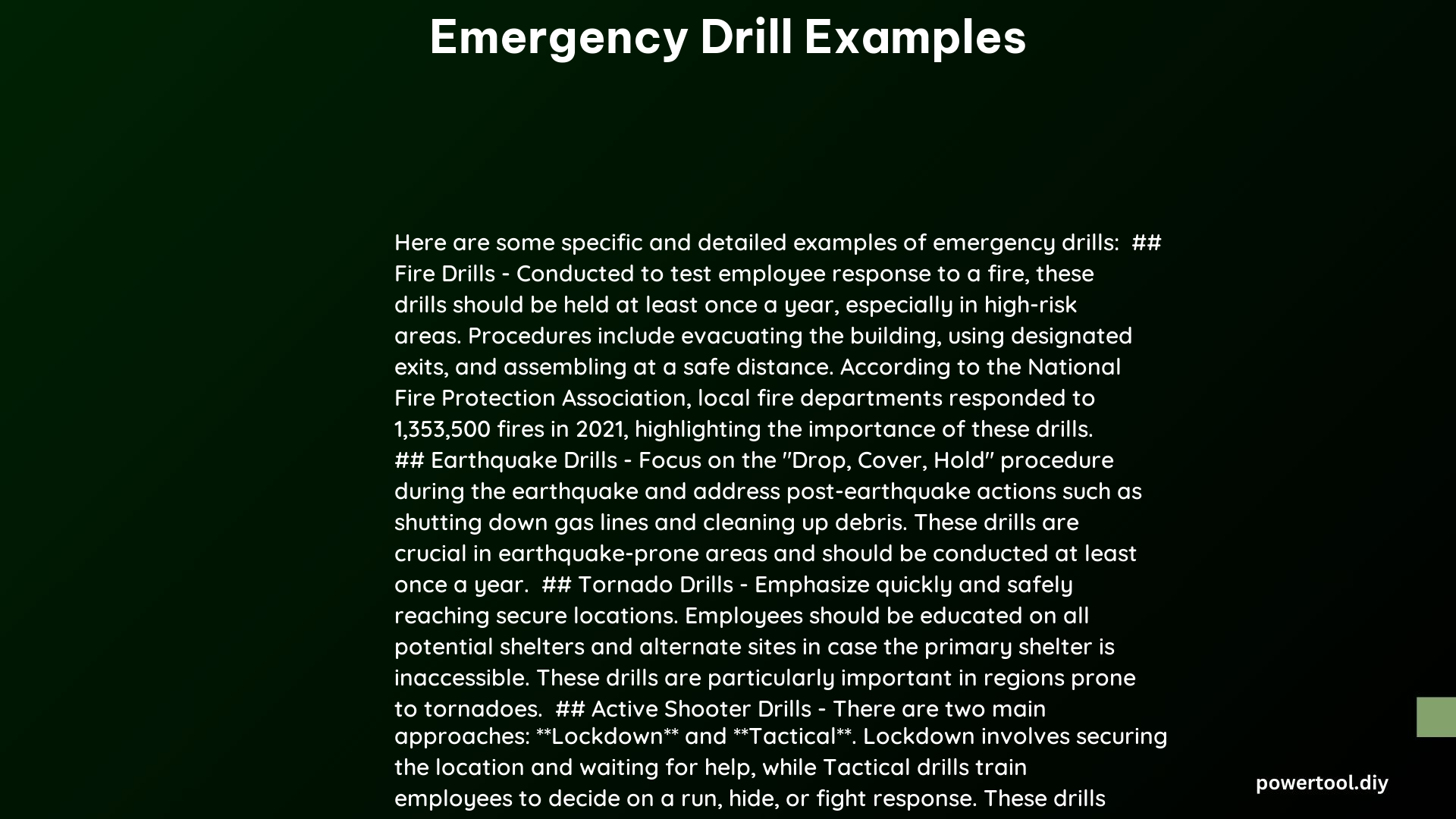Emergency drill examples are essential for preparing organizations and individuals for various crisis scenarios. These drills simulate real-life emergencies, allowing participants to practice response procedures, identify weaknesses, and improve overall safety protocols. From fire evacuations to active shooter situations, emergency drills cover a wide range of potential threats, ensuring readiness for diverse crisis events.
What are the Most Common Types of Emergency Drills?
- Fire Drills
- Earthquake Drills
- Active Shooter Drills
- Tornado Drills
- Hazardous Material Spill Drills
- Medical Emergency Drills
How to Conduct an Effective Fire Drill?

Fire drills are crucial for ensuring the safety of building occupants during a fire emergency. Here’s a step-by-step guide to conducting an effective fire drill:
- Alarm Activation: Trigger the fire alarm system (80+ decibels).
- Evacuation: All occupants must leave the building immediately.
- Assembly: Gather at a pre-designated assembly point.
- Roll Call: Account for all evacuees using a sign-in sheet.
- All Clear: Sound the all-clear signal to end the drill.
| Role | Responsibility |
|---|---|
| Wardens | Guide evacuation, manage traffic flow |
| First Aiders | Provide medical assistance if needed |
| Occupants | Follow instructions, evacuate promptly |
What are the Key Components of an Earthquake Drill?
Earthquake drills prepare individuals for the sudden and unpredictable nature of seismic events. The primary components include:
- Drop, Cover, and Hold On: Participants practice taking immediate protective action.
- Evacuation: If necessary, practice evacuating to a safe outdoor area.
- Building Assessment: Simulate checking for structural damage post-quake.
- Communication: Test emergency communication systems and protocols.
How to Implement an Active Shooter Drill?
Active shooter drills are increasingly important in today’s security landscape. Key elements include:
- Lockdown Procedure: Practice securing rooms and hiding from view.
- Run, Hide, Fight: Train participants in decision-making during an active threat.
- Communication: Test alert systems and practice notifying authorities.
- Evacuation: Practice safe evacuation routes if escape is possible.
What are the Essential Elements of a Tornado Drill?
Tornado drills focus on rapid response to severe weather warnings:
- Warning System: Test tornado warning sirens or alert systems.
- Shelter Locations: Identify and practice moving to designated safe areas.
- Timing: Aim for quick relocation, typically within 3-5 minutes.
- All Clear: Practice waiting for official all-clear before leaving shelter.
How to Organize a Hazardous Material Spill Drill?
Hazardous material (HazMat) spill drills are crucial for facilities handling dangerous substances:
- Spill Identification: Practice recognizing and reporting spills.
- Containment: Simulate containment procedures using appropriate equipment.
- Evacuation: Practice evacuating affected areas if necessary.
- Decontamination: Simulate decontamination procedures for exposed individuals.
What Should be Included in a Medical Emergency Drill?
Medical emergency drills prepare staff for sudden health crises:
- First Aid Response: Practice immediate first aid techniques.
- Emergency Services Contact: Simulate calling for professional medical help.
- AED Use: Practice using Automated External Defibrillators if available.
- Patient Transport: Simulate moving patients safely if required.
How Often Should Emergency Drills be Conducted?
The frequency of emergency drills depends on various factors:
| Type of Drill | Recommended Frequency |
|---|---|
| Fire Drill | Monthly to Quarterly |
| Earthquake Drill | Annually to Bi-annually |
| Active Shooter Drill | Annually |
| Tornado Drill | Seasonally (Spring/Summer) |
| HazMat Spill Drill | Annually |
| Medical Emergency Drill | Quarterly |
What are the Legal Requirements for Emergency Drills?
Legal requirements for emergency drills vary by location and industry:
- OSHA Regulations: U.S. workplaces must comply with OSHA emergency action plan requirements.
- Local Fire Codes: Many jurisdictions mandate regular fire drills for businesses and schools.
- Industry-Specific Rules: Certain industries (e.g., healthcare, education) have additional drill requirements.
Always consult local authorities and industry regulations for specific requirements in your area.
By implementing these emergency drill examples, organizations can significantly improve their preparedness for various crisis scenarios, ensuring the safety of their occupants and compliance with relevant regulations.
References:
1. AlertMedia – Emergency Drills for the Workplace
2. Illinois State University Emergency Management – Drills and Exercises
3. Methodist Church of New Zealand – Emergency Response Drill Scenarios
